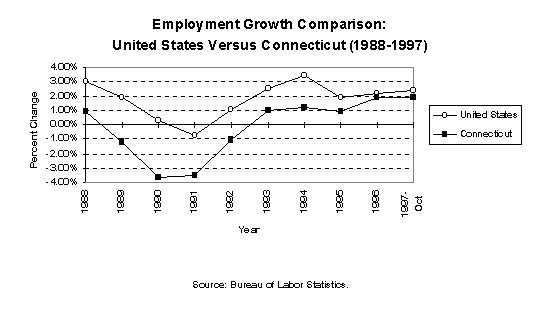
ECONOMIC CONDITION AND OUTLOOKRECENT TRENDS
Connecticut's economy was slow to recover from a recession that officially began in February 1989 and ended in December 1992. Prior to the recession, Connecticut was performing better than the nation as a whole in two critical economic areas; it had an unemployment rate that was well below that of the nation and state incomes were rising at a rate above the national average.
However, throughout the recession and the early recovery period this trend was reversed as Connecticut's economy fell further than the national economy and was slower to recover. Over the past fiscal year, Connecticut has demonstrated renewed strength with employment growing at its fastest rate in more than a decade, accompanied by rising wages.
Despite the recent positive overall economic growth in the state, some disturbing trends persist. Over the past five years, inflation adjusted median household income in Connecticut has declined by 7.8 percent. This is largely due to the fact that the jobs gained during the recovery pay approximately 30 percent less than the jobs that were lost during the recession. The present positive growth in wages and earnings has not been sufficient to fully compensate for the lower wage bases of the newly created jobs.
In addition, the unemployment rates in our major cities, while showing some improvement, remain significantly above the statewide average. The high rates of urban unemployment contribute to growing income inequality in the state. In measuring family income, Connecticut families in the top 20 percent have incomes that are 14.2 times higher than those in the bottom 20 percent. This ranks Connecticut as one of the country's top five states in terms of income inequality. Continued strong economic growth in conjunction with state policies that are sensitive to these issues can help to reverse these trends.
Employment
During the recession of the early 1990's, Connecticut lost 158,200 jobs, which represented about 9.5
percent of the state's total employment. The largest job loss occurred in the manufacturing sector,
which has continued to lose jobs. Job losses also persist in the finance, insurance, and real estate
sector. Through the present recovery, Connecticut has regained 101,900 jobs, or 64.4 percent of its
total job loss (figures as of October 1997). During the early part of the recovery, Connecticut job
gains were running well below the national average; however, over the past two years Connecticut's
job growth has been consistent with the national trend.
The following graph compares employment growth for Connecticut and the nation over the last decade.

The composition of employment in the state has changed significantly over the past decade as high paying manufacturing jobs were replaced by lower paying service sector jobs. Most of the decline in the manufacturing sector is the result of reductions in federal defense spending. Connecticut's defense contract revenues dropped by 65 percent between 1985 and 1995. The strongest job gains within the service sector have been in recreational services and health care related services. The pie charts that follow demonstrate the employment shifts that have occurred in Connecticut's labor market between 1987 and 1996.
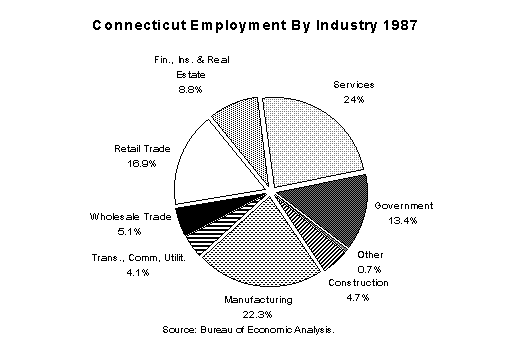

Connecticut's unemployment rate, like the national unemployment rate, has been declining since the recovery began at the end of 1992. The state's seasonally adjusted unemployment rate was 4.7 percent (81,900 unemployed workers) in October 1997, identical to the national rate.
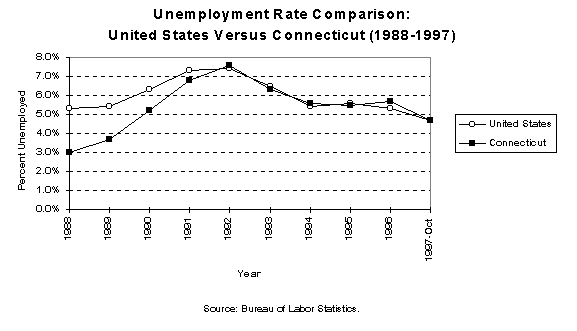
While the state's overall unemployment rate is relatively low, Connecticut's urban centers continue to struggle with above average rates of unemployment. Since the state's overall population is fairly stagnant, and some areas of our state are actually approaching full employment, Connecticut must rely on its cities for future employment growth. This will require government policies and programs that provide education and transportation systems that match private market demands with the untapped urban labor force.
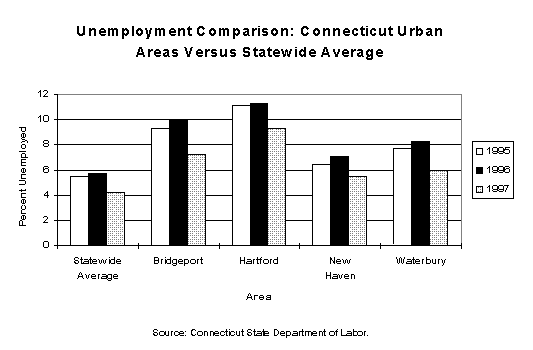
Income
Connecticut's per capita income for 1996 was $33,875, the highest among the 50 states and almost
40 percent above the national average. Per capita income increased at a 4.7 percent rate in 1996.
Projections based on data from the Bureau of Economic Analysis at the end of the second quarter
of 1997 show state per capita income growth for 1997 exceeding that of 1996.
The graph that follows compares growth in per capita income over the last decade for Connecticut and the nation as a whole.
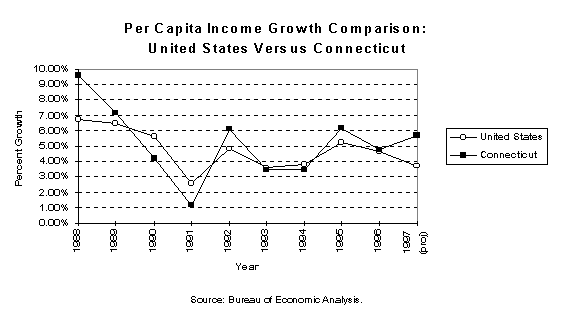
In Connecticut, there are strong regional disparities in income. The 10 municipalities with the lowest per capita income (Hartford, Mansfield, New London, Bridgeport, Windham, Plainfield, New Haven, Killingly, Sprague, and Stafford) have an average per capita income that is 3.5 times lower than the top 10 municipalities (New Canaan, Weston, Darien, Greenwich, Westport, Wilton, Redding, Avon, Woodbridge, Sherman).
Total wage and salary income in the state has also risen steadily. After years of performing below national growth rates in this category, it is projected that growth in Connecticut will exceed the national figure in 1997.

Despite the positive growth in per capita income and total salary and wage income, some disturbing trends persist. State median household income adjusted for inflation has actually declined by 7.8 percent over the past five years. Median income is a measurement that factors out very high and very low incomes, thus providing a better measurement of the typical household income in the state. Real median household income in the state for 1996 is $42,119, which places Connecticut 18.7 percent above the nationwide figure of $35,492.
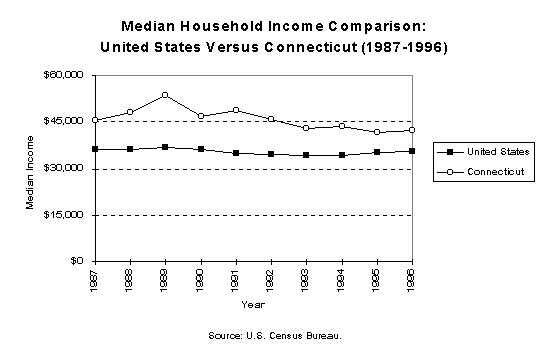
A large part of the decline in real median household income can be attributed to the shift of employment from higher paying manufacturing jobs to lower paying service sector jobs. For example, electronics manufacturing -- which experienced an employment decline of 44 percent between 1987 and 1996 -- had an average annual 1996 wage and salary level of $56,010. Health services -- which experienced a 33 percent increase in employment over the past 10 years -- had an average annual 1996 wage and salary level of $34,765. Even with solid wage growth, it will take time before the service sector wage base reaches the present wage and salary level of the manufacturing sector.
Another factor contributing to the negative growth trend in real median family income is the aging of Connecticut's labor force. As the labor force ages, less money income is derived from salary and wages and more comes from transfer payments (such as social security and government pensions). Approximately 58 percent of total state personal income came from wages and salaries in 1987. This number declined to 54 percent by 1996. The amount of state personal income contributed by transfer payments rose during this period from 10 percent to 13 percent.
There is a high degree of income inequality in Connecticut. According to a study by The Center on Budget and Policy priorities, Connecticut ranks fifth in the nation in income inequality. For the years 1994 through 1996, the average family income of the top 20 percent in the state was 14.2 times higher than the bottom 20 percent. The top fifth had average income of $147,594 and the bottom fifth had income of $10,415. Nationally, the top fifth of families have income that is 12.7 times higher than the bottom fifth.
Other Indicators
Most indicators of present and future state economic activity are trending up. Housing permits and
new business starts, both indicators of future state economic growth, are up from the third quarter
of 1996 to the third quarter of 1997. Housing permits during the period rose 10.9 percent, and new
business starts were up 25.4 percent.
In June of 1997, a 24.6 percent increase was recorded in state exports from the prior 12 month period. Exports represent an important component in Connecticut's economic development strategy.